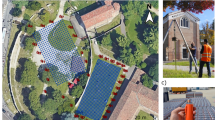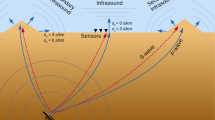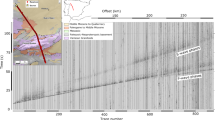Abstract
MOST seismological observatories operate narrow band recording systems that record only that part of the seismic spectrum in which the signal/noise ratio is usually a maximum. These systems are ideal for detecting small seismic signals (say body wave magnitude mb 4.0 to 5.0) such as those generated by underground explosions of a few kton but have the disadvantage that the recorded signals are distorted versions of the true ground motion. To study seismic source functions particularly from body waves requires a broad band (BB) system such as the Kirnos system operated in the USSR1 which has a constant magnification over the range 0.1 Hz to 10 Hz. The drawback of such systems is that the recording band includes the strong microseismic peak at around 0.17 Hz and thus only relatively large signals, above ∼mb = 5.5, are recorded. Here we describe how both broad band and narrow band recordings can be obtained from a single conventional long period (LP) seismometer. The chief cost of adding a broad band system to an established observatory is then the provision of a suitable recorder. We also try to demonstrate the advantages of BB recording.
This is a preview of subscription content, access via your institution
Access options
Subscribe to this journal
Receive 51 print issues and online access
$199.00 per year
only $3.90 per issue
Buy this article
- Purchase on Springer Link
- Instant access to full article PDF
Prices may be subject to local taxes which are calculated during checkout
Similar content being viewed by others
References
Willmore, P. L., and Karnik, V., ISC Manual of Seismological Observatory Practice (Edinburgh, 1970).
SIPRI, Seismic Methods for Monitoring Underground Explosions (Almqvist and Wiksell, Sweden, 1969).
Kondorskaya, N. V., and Aponovich, Z. I., Bull. Ist. Acad. Sci., USSR, 7 (1971).
Riznichenko, Yu. V., Trans. of the O. Yu. Shmidt Institute of Geophysics, No. 15, 182 (1960) (published in Translation by Consultants Bureau Enterprise, New York, 1962).
Author information
Authors and Affiliations
Rights and permissions
About this article
Cite this article
MARSHALL, P., BURCH, R. & DOUGLAS, A. How and Why to Record Broad Band Seismic Signals. Nature 239, 154–155 (1972). https://doi.org/10.1038/239154a0
Received:
Issue Date:
DOI: https://doi.org/10.1038/239154a0
This article is cited by
-
Forensic seismology revisited
Surveys in Geophysics (2007)
-
Recognising simulated earthquakes
Nature (1976)
Comments
By submitting a comment you agree to abide by our Terms and Community Guidelines. If you find something abusive or that does not comply with our terms or guidelines please flag it as inappropriate.



